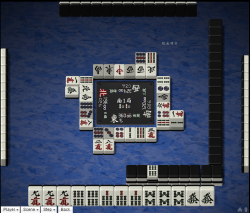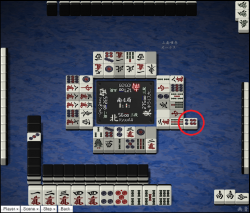Furiten

Furiten 「振聴」, meaning sacred discard, is a particular rule associated with the tile discards. Basically, the player in tenpai is furiten if winning tiles are present in one's own discard pile or, in certain conditions, another player's discard pile or shouminkan. Players in furiten may still win by tsumo, but not by ron. A call of ron while furiten is penalized by chombo.
In all cases, the furiten rule requires a player to be aware of all of their tile waits. If a player is tenpai but does not realize all of their possible waits, they may not be aware that they are furiten and, as a result, call an illegal win. This is especially true of a player who has called riichi, because they can be furiten off of anyone's discard.
Unlike many other mahjong variations, the discard pile for Japanese mahjong is specifically arranged in front of players. The orderly discards help enforce the furiten rule, by keeping track of discarded tiles. Tile calls have specific arrangements to point the source of these discarded tiles, so that they do not allow a loophole to furiten. For every discard, the furiten rule applies when appropriate.
The rule
Furiten imposes the following conditions:
- Players in furiten may not win by ron, under any circumstances.
- Declaring ron while in furiten is penalized with a chombo payment.
- Players in furiten may still win by tsumo.
Causes
When a player has called a win, via the call for ron, their hand should be checked for furiten. If the player is found to be furiten, then the win is invalid and the penalty for chombo is enforced. For games played via the computer, players are usually denied the ability to declare ron in the first place.
Discard-based furiten
A player is furiten if a winning tile is present in his own's discard pile. It does not matter whether this tile would have provided a yaku or not. Tiles turned sideways within open groups are considered part of the discarder's discard pile, hence the concern for indicating the tile source for open calls. As long as the player has not declared riichi, furiten can be avoided by altering the hand and changing tile waits.
Example tenpai hand
This hand waits on three different tiles. If the player has a 2-pin their discard pile, then the hand is in furiten and may not win by ron on any tile. Even if a 5-pin or 8-pin gets discarded by an opponent, ron may not be called in this instance.
Permanent furiten during riichi
A riichi declarer may ignore a winning tile and not call ron. The ignored tile may have been a discarded tile or a tile used to extend a minkou to a shominkan (kan called while having an open triplet). After ignoring a winning tile, the riichi declarer is permanently furiten for the rest of the hand. Therefore, it is advised for any player declaring riichi to call ron, at the first instance of a winning tile. Otherwise, a win via tsumo becomes the only option.
The furiten rule emphasizes that all tiles discarded by any player after the riichi declaration are deemed safe tiles, along with the player's own discards. For this reason, the tile upon the riichi declaration is turned sideways to indicate the timing of the call. Riichi declarers may not decline a ron against one player and expect to declare ron against another. Even if a winning tile different from the ignored one appears, the player may not call ron.
Temporary furiten

Any player in tenpai has the option to ignore winning tiles. By declining a call for ron, the player then becomes temporarily furiten until the same player's next discard. In some plays, this may be a valid option in order to achieve a higher scoring hand or to target a specific player.
The furiten rule does not consider yaku. Sometimes, a hand can be completed with several tiles, but only some of them provide a yaku, others would produce a yakuless hand. If a yakuless tile appears, it must be ignored, because a winning hand must contain a yaku. The player must remain temporarily furiten until the next turn, even if a potential winning tile appears.
This rule makes it harder to target a specific player with ron, or to ignore a winning tile of lesser value and hope for a more valuable tile. Sometimes, a player simply needs a specific win condition in order to attain a certain result, like passing another player. Win conditions that do not meet certain expectations may end up being ignored.ile giving more value
Some rulesets may vary the rules on temporary furiten with regards the timing of its cancellation, where a tile call made by another player cancels the temporary furiten state. This is an uncommon variation, however.
Strategy
Defense
The furiten rule may be applied for defensive play, which focuses on discarding safe tiles. By discarding tiles that are also visible in an opponent's discard pile, a player can avoid a ron call by that opponent. Likewise, usage of suji and kabe may also help players deduce safe tiles, based on opponent discard. This is applied when a player does not have any matching tiles in the hand with opponent discard; or a player may rather keep certain tiles, for the sake of developing the hand without tearing it apart.
Working with furiten
Sometimes, it may be necessary to deliberately place the hand in furiten. Often, this is the result of developing the hand and defending simultaneously. To escape the bind applied by furiten, then the hand's tile wait(s) must simply change by adjusting and changing the tiles in the hand with subsequent tile draws. Of course, a player may place greater expectation on tsumo to win rather than ron.
Furiten tsumo
Hands in furiten can still win, as furiten imposes a limit of tsumo only. For open hands, the hand requires a valid yaku. For closed hands, mentsumo will be acceptable or added.
External links
- Furiten in Japanese Wikipedia